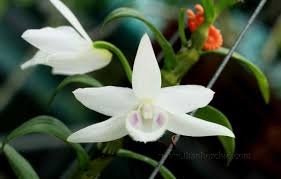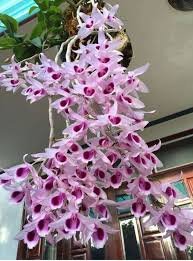# Secrets to the Rapid and Sustainable Growth of Phi Diep Orchids

Phi Diep orchids (*Dendrobium anosmum*), renowned for their vibrant colors and enchanting fragrances, have become a favorite among both casual gardeners and serious orchid enthusiasts. Their exotic beauty, combined with their adaptability to various growing conditions, makes them a popular choice for indoor and outdoor cultivation. However, achieving optimal growth requires an understanding of the specific needs of these orchids. This article will explore the secrets to fostering the rapid and sustainable growth of Phi Diep orchids, covering aspects such as proper care, environmental conditions, nutrition, and pest management.
—
### 1. Understanding Phi Diep Orchids
#### 1.1 Origin and Characteristics
Phi Diep orchids are native to Southeast Asia, particularly in areas with warm, humid climates. They thrive in the dappled light of the forest understory, growing as epiphytes on trees. The key characteristics of Phi Diep orchids include:
– **Growth Habit:** They typically grow in clumps with long, arching canes that can reach up to three feet in length.
– **Flowers:** The flowers are usually trumpet-shaped and come in various colors, including white, pink, and purple, often with striking markings.
– **Seasonality:** These orchids generally bloom in the spring, but with the right conditions, they can flower multiple times a year.
#### 1.2 Importance of Care
Caring for Phi Diep orchids involves understanding their specific needs, which differ from other types of orchids. Proper care not only promotes healthy growth but also enhances blooming and extends the life of the plant.
—
### 2. Optimal Growing Conditions
#### 2.1 Light Requirements
Light is one of the most critical factors affecting the growth of Phi Diep orchids. Here’s how to provide optimal lighting:
– **Indirect Sunlight:** Phi Diep orchids prefer bright, indirect sunlight. Too much direct sunlight can scorch the leaves, while too little light may hinder blooming.
– **Light Duration:** Aim for 10-12 hours of light daily. Using grow lights can help supplement natural light, especially in darker months.
– **Seasonal Adjustments:** Monitor light exposure throughout the seasons, adjusting the position of your orchids as necessary to ensure they receive adequate light.
#### 2.2 Temperature and Humidity
Creating a stable and suitable climate is essential for rapid growth:
– **Temperature Range:** Phi Diep orchids thrive in temperatures between 65°F to 85°F (18°C to 29°C) during the day and slightly cooler at night. Sudden temperature changes can stress the plants.
– **Humidity Levels:** Aim for humidity levels between 50% and 70%. You can increase humidity by using humidifiers, pebble trays with water, or grouping plants together.
#### 2.3 Air Circulation
Good air circulation is vital for preventing fungal diseases and promoting healthy growth:
– **Ventilation:** Ensure that your growing area is well-ventilated. Avoid placing orchids in enclosed spaces without airflow.
– **Fans:** Use fans to improve air circulation, especially in humid environments, to prevent stagnant air.
—
### 3. Potting and Growing Media
#### 3.1 Choosing the Right Pot
Selecting the appropriate pot is crucial for the health of your Phi Diep orchids:
– **Material:** Terra cotta pots are ideal as they allow for good air exchange and moisture regulation. Plastic pots are also suitable if they have adequate drainage holes.
– **Size:** Choose a pot that allows for root growth without being excessively large, as too much media can retain moisture and lead to root rot.
#### 3.2 Suitable Growing Media
The growing medium plays a vital role in water retention and drainage:
– **Orchid Mix:** Use a well-draining orchid mix, typically made of bark, perlite, and charcoal, to provide the right balance of moisture and airflow.
– **Customization:** Consider customizing the mix to suit your specific growing conditions. For example, adding more perlite can enhance drainage in humid environments.
—
### 4. Watering Techniques
#### 4.1 Watering Frequency
Proper watering is essential for the rapid growth of Phi Diep orchids:
– **General Rule:** Water your orchids when the top inch of the growing medium feels dry to the touch. This usually translates to watering every 5-7 days during the growing season and less frequently in the winter.
– **Environmental Factors:** Adjust your watering frequency based on environmental conditions such as temperature, humidity, and pot size.
#### 4.2 Water Quality
The quality of water used for irrigation can significantly affect plant health:
– **pH Levels:** Aim for water with a pH between 6.0 and 7.0. Distilled or rainwater is often best, as tap water can contain chemicals like chlorine or fluoride that may harm orchids.
– **Temperature:** Water your orchids with room-temperature water to avoid shocking the roots.
#### 4.3 Watering Methods
Different watering techniques can also impact growth:
– **Soaking Method:** Soak pots in a basin of water for about 30 minutes, allowing the media to absorb moisture evenly before draining.
– **Bottom Watering:** This technique involves placing the pot in a tray of water, allowing the media to draw moisture from the bottom, which can help prevent overwatering.
—
### 5. Nutritional Needs
#### 5.1 Fertilization Schedule
Providing adequate nutrition is essential for promoting rapid growth and flowering:
– **Fertilizer Type:** Use a balanced orchid fertilizer with a higher phosphorus ratio during the blooming season (e.g., 30-10-10) to encourage flower production.
– **Frequency:** Fertilize every 4-6 weeks during the growing season, and reduce to once every 8-12 weeks during dormancy.
– **Dilution:** Always dilute fertilizer to half-strength to prevent root burn, especially for young or newly repotted orchids.
#### 5.2 Organic Alternatives
Consider organic fertilizers as a sustainable option:
– **Compost Tea:** A diluted solution of compost can provide essential nutrients without the risk of chemical buildup.
– **Fish Emulsion:** Rich in nitrogen, fish emulsion can stimulate healthy foliage growth.
—
### 6. Pruning and Maintenance
#### 6.1 Regular Pruning
Regular pruning helps promote healthy growth and flowering:
– **Remove Dead Leaves:** Regularly check for and remove dead or yellowing leaves, which can harbor pests and diseases.
– **Cutting Flower Stalks:** After blooming, cut the flower stalk just above the node to encourage further growth and potential reblooming.
#### 6.2 Repotting
Repotting is vital for healthy growth, especially if the orchid has outgrown its pot or the growing medium has broken down:
– **Timing:** Repot during the spring or after blooming, when the plant is actively growing.
– **Process:** Gently remove the orchid from its pot, trim any dead or rotting roots, and place it in fresh growing media.
—
### 7. Pest Management
#### 7.1 Common Pests
Phi Diep orchids can be susceptible to several pests:
– **Aphids:** Small, sap-sucking insects that can weaken plants. Treat infestations with insecticidal soap.
– **Mealybugs:** White, cottony pests that can be removed with a cotton swab dipped in alcohol.
– **Spider Mites:** These tiny pests thrive in dry conditions. Increase humidity to deter them and treat with neem oil if necessary.
#### 7.2 Disease Prevention
Preventing diseases is crucial for the longevity of your orchids:
– **Fungal Infections:** Ensure proper air circulation and avoid overwatering to prevent root rot and fungal issues.
– **Bacterial Wilt:** Remove any infected plants immediately to prevent the spread of disease.
—
### 8. Special Techniques for Sustainable Growth
#### 8.1 Mounting Orchids
Mounting Phi Diep orchids on wood or bark can provide a natural aesthetic while promoting healthy growth:
– **Materials:** Use untreated wood such as cedar or cork for mounting. Make sure the surface is rough to allow roots to attach.
– **Technique:** Attach the orchid with fishing line or wire, providing adequate moisture with regular misting.
#### 8.2 Companion Planting
Companion planting can enhance growth and deter pests:
– **Choose Compatible Plants:** Consider growing Phi Diep orchids alongside other epiphytic plants that thrive in similar conditions.
– **Natural Pest Control:** Planting herbs such as basil or mint can help repel pests naturally.
—
### 9. Understanding Seasonal Changes
#### 9.1 Spring Growth
Spring is the active growth period for Phi Diep orchids:
– **Increase Watering and Fertilization:** As temperatures rise, adjust your watering and fertilization schedule to promote growth.
– **Monitor for Pests:** With increased growth comes increased vulnerability to pests, so remain vigilant.
#### 9.2 Summer Care
In summer, the focus shifts to maintaining humidity and light levels:
– **Protect from Direct Sunlight:** Ensure orchids are shielded from harsh midday sun.
– **Humidity Management:** Use misters or humidity trays to maintain moisture levels.
#### 9.3 Fall and Winter Dormancy
During fall and winter, Phi Diep orchids enter a period of dormancy:
– **Reduce Watering:** Cut back on watering and fertilization, allowing the plant to rest.
– **Temperature Monitoring:** Ensure they are kept in a stable, warm environment to prevent stress.
—
### 10. Conclusion
Successfully cultivating Phi Diep orchids requires a combination of knowledge, patience, and attention to detail. By understanding their specific needs for light, temperature, humidity, nutrition, and pest management, you can unlock the secrets to their rapid and sustainable growth.
Implementing the techniques outlined in this article will not only enhance the health and vitality of your Phi Diep orchids but also reward you with breathtaking blooms and a lasting appreciation for these
exquisite plants. Whether you are a novice gardener or an experienced orchid enthusiast, the joy of nurturing Phi Diep orchids can be a truly rewarding experience that brings beauty and tranquility to your space. With care and dedication, your Phi Diep orchids will flourish, becoming a stunning centerpiece in any garden or home.


















